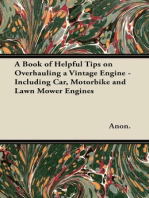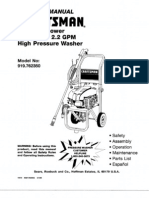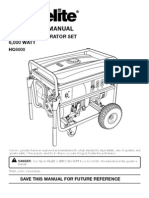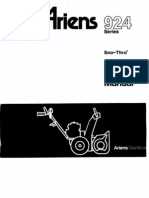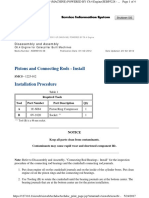Troubleshooting and Repair
Uploaded by
sorintatarTroubleshooting and Repair
Uploaded by
sorintatar4-MIX Troubleshooting and Repair
Before any repair work is performed on a machine, a thorough evaluation should be made
to determine what parts are actually in need of replacement or maintenance. The service
manuals for STIHL 4-MIX engines outline testing procedures as well as special tools that
are needed to repair the equipment.
The STIHL troubleshooting video and corresponding iCademy module are ideal checklists
to use when performing repairs and will assist the technician in performing a step by step
analysis of the machine.
Repair Procedures: Quick Check
The fastest way to find any major fault is to quickly check for compression, ignition, spark,
and fuel delivery.
Use a spark tester to verify that spark is present.
If the engine has no spark, the spark plug, the ignition module or stop switch
system is at fault.
If the fuel system is completely restricted, the engine may not fire at all when trying
to start it. Squirt some choke spray in the carburetor and try to start the engine.
Does the engine have any
compression?
Is fuel getting to the
combustion chamber?
Does the engine have
spark?
On 4-MIX engines, if compression feels low, or if the spark is okay and fuel is getting to
the engine, then do a leak down test.
This only takes a few minutes. If the leak down is below 10%, then the combustion
chamber is okay and the running problems are due to something else.
If the leak down is greater than 10%, the problem needs to be repaired, as well as
making sure that there are no other faults present.
If leak down is less than 10%
on a 4-MIX
engine, check for
faults elsewhere.
If leak down is greater than 10%, the
engine will need service, but check for
any other faults before doing any
repair.
Click to download the STIHL 4-MIX Engine Check Worksheet.
The STIHL 4-MIX Engine Check Worksheet is a simple guide to verify any faults
found in a logical and efficient manner.
Worksheets are available for both 2-cycle and 4-MIX engines.
An accurate repair cost estimate can then be prepared.
Throttle Operation
Verify that the throttle works smoothly, and that the throttle interlock is working correctly.
The throttle cable should be adjusted so that the throttle is opening all the way to
the stop on the carburetor without causing excessive tension on the cable.
Example A.
Be sure that the throttle returns to idle easily and smoothly.
On a shaft mounted 4-MIX product, inspect the cable for fraying where it slides
over the plastic cam on the carburetor flange. Example B.
B
A
4180 Series Throttle Adjustment Procedure
To adjust the throttle correctly on a shaft mounted product, set the screw on the
adjuster cam that is located on the carburetor flange so the same amount of
threads show on either side of the cam.
Next, using a small screwdriver, push down on the tab located in the top of the
throttle assembly and slide the tab towards the engine.
Now squeeze the throttle to the wide open position. The tab will slide forward and
automatically adjust the throttle cable. Release the throttle trigger and verify that
the throttle lever comes back fully to idle.
6
5
4
3
2
1
The throttle cable should always be checked for proper adjustment when a new machine is
set up for delivery and anytime a machine is in for service.
4282 Series Throttle Cable Adjustment
If the throttle is not opening all the way on a backpack blower, performance and
engine cooling will suffer.
To adjust the throttle cable on a 4-MIX blower, turn the small screw that is located
in the throttle trigger until the proper throttle opening is achieved.
Ignition Module
Check for spark with a spark tester that loads the ignition module.
Modules can have intermittent faults: Heat related failures where the spark returns
after the module cools down, or even show spark but not start the engine.
Check for spark. The spark plug must be installed in the cylinder when performing
an ignition module test with the STIHL ZAT 4.
Holding the plug against the cylinder and pulling the starter rope is not a valid test
of an ignition module.
Inspect the spark plug and verify heat range.
Verify that the correct spark plug is installed. The spark plug for an FS 100 is hotter
than the spark plug for a BR 600.
If an incorrect spark plug is installed in a BR 600, the engine may quit after it warms
up, or it may run poorly. It may also try to run-on when the ignition is switched off.
Set the gap on all STIHL spark plugs at twenty thousands of an inch.
The final verification of a faulty ignition module may have to be done by replacing it
with a known good ignition module for comparison.
FS 90, FS 100, FS 110,
KM 110, FC 100, FC 110,
HT 100, HT 101 , HL 100
FS 130, KM 130,
HT 130, HT 131
BR 500, BR 550, BR 600
STIHL 0000 400 7009
Bosch USR7AC
NGK CMR5H
STIHL 0000 400 7011
NGK CMR6H
Refer to the STIHL repair specification charts for other models.
Air Filters
Air filters should be inspected and cleaned regularly. Filters should be replaced at least
once a year, or more often if needed.
The air filter element used on the 4-MIX shaft mounted engines should never be
cleaned in solvent. Brush off any loose debris and clean it with compressed air.
STIHL backpack blower engines use a pleated paper air filter. The only way to
service it is to brush off any debris or gently blow it off. Do not use high pressure
air or the pleats may tear.
Always inspect the clean side of the filter housing for any evidence of dirt or grit. If
dirt is present, the filter needs to be serviced more often.
Flywheel
Fault A sheared flywheel key.
Occurs when: The nut is not properly tightened, or if an impact wrench is used to
loosen or tighten the fan wheel, flywheel, clutch, or starter cup nut.
A sheared key may not cause the ignition module to lose spark, so the spark tester
will not show a fault.
Key is sheared.
Never use an
impact wrench
on any STIHL
product!
Verify flywheel timing.
The shaft mounted 4-MIX engines have a timing arrow on the flywheel that should
point at the ignition module mounting screw as a reference point when the piston
is at top dead center.
For the 4-MIX blower engine the S marked corner on the flywheel should be just
at the edge of the ignition armature leg when the piston is at top dead center.
Shaft Mounted Engine
Ignition Module Air Gap.
The specification for the ignition module to flywheel air gap is eight thousandths of
an inch for all 4-MIX engines.
The STIHL setting gauge can be used to check and properly adjust the air gap.
STIHL Part # 4118 890 6401.
Backpack Blower Engine
Backpack Blowers
4282 Series
Shafted Products
4180 Series
Valve Clearance
Break-in and normal wear tend to open up the valve clearance, and may lead to a loss of
power and performance.
The valve clearance for all 4-MIX engines is 0.1 mm. or four thousandths of an inch
when the engine is cold.
The instruction manual suggests checking the valve clearance around 135 hours of
operation.
A cylinder pressure leak down test will allow you to quickly determine the condition
of the valves and piston rings without disassembling the engine.
A special feeler gauge is required to check the minimum valve clearance. STIHL Part
# 4180 893 6400.
Check val ve
adjustments
Leakage % is
indicated on gauge
that is connected
to cylinder.
Adjust regulator
gauge to the set-
point.
Engine - Leak Down Test
Test the 4-MIX engine for leaks.
Connect the gauge to the engine and read the amount of leakage.
There may be a little leakage past the end-gaps of the rings. If leakage is
less than 10% the sealing of the combustion chamber is acceptable.
If leakage is over 10% you will need to identify the area of leakage and repair the
leak.
Listen at the muffler, carburetor, flange inlet, or where the push rods come up from
the cam. A rushing air sound should be evident at one of these locations, verifying
the location of the leakage from the engine.
The leak down tester recommended by STIHL has a smaller air inlet orifice and is designed
for testing any small engine.
Crankcase - Vacuum & Pressure Test
Install the rubber block off plate between the muffler gasket and the engine and
install a flange adapter in place of the carburetor. Be sure to block the impulse
hose.
When checking the crankcase for leaks, pressurize the crankcase to a reading of
positive 0.5 bar, or about 7 pounds per square inch. The pressure should not leak
down to positive 0.3 bar, or about 4 pounds per square inch, in 20 seconds. If it will
not hold pressure or leaks down too fast, locate the leak with a soapy water
solution.
To perform a crankcase pressure and vacuum test the intake port and exhaust port must
be sealed with the proper blocking tools. STIHL 4-MIX engines need to also have the
valve cover installed.
Gauge readings.
If the crankcase holds pressure, then apply a vacuum of negative 0.5 bar, or about
negative 7 pounds per square inch. The vacuum reading should not leak to above
negative 0.3 bar, or about negative 4 pounds per square inch, in 20 seconds.
If the engine has a vacuum leak, but no pressure leak, the fault is most likely a
crankshaft seal. Expose each seal and position the engine with the seal facing up,
spray some light penetrating lubricant on the seal around the crankshaft and apply
a vacuum with the tester to see if any of the liquid is sucked into the seal.
Vacuum
Range
Pressure
Range
Impulse Line
Check impulse line for blockage.
One method to check the impulse is to use a small carburetor pressure tester, and
hook it to the impulse hose.
When you pull the starter rope, the needle on the gauge should bounce back and
forth indicating positive and negative pressure. If nothing happens, the impulse
line or impulse passageway is restricted.
If the starter is not assembled to the engine you can connect a carburetor testing
gauge to the impulse hose when you perform a crankcase pressure and vacuum
test.
The needle on the carburetor gauge should move as pressure and vacuum are
applied to the crankcase.
If the impulse line becomes blocked, the running behavior of the engine will indicate
carburetor problems, when in fact there may be none.
Carburetors
Inspect carburetor visually.
Before testing or disassembly, visually inspect the carburetor for damage.
If something on the carburetor is physically broken or worn, most likely the
carburetor will need replacing and no further time will be spent on evaluation.
If the carburetor has no physical damage and the throttle shaft is tight, then perform
a three step evaluation with a carburetor pressure tester, such as a ZAMA ZPG-1.
This will allow any internal faults in the carburetor to be identified quickly.
Fuel Leak Indicated by
Dirt Build-up
Worn Throttle Shaft
Worn Mounting Surface
Three step evaluation for a 4-MIX engine used on shafted products.
Step 1: Hook the gauge to the inlet fitting on the carburetor, and
pump it to no more than 10 PSI. The gauge reading should hold steady. If not, immerse
the carburetor in water and identify where it is leaking. If bubbles come out of the
venturi, the inlet needle is leaking. If the bubbles come out around the fuel pump
side or primer flange then the cause of the leak is most likely loose screws or
damaged gaskets. The pressure gauge must hold steady at 10 PSI before
performing step 2.
Step 2: While the carburetor is still under pressure from step 1, pump the primer
bulb and the needle on the gauge should drop. Continue until the gauge reading
indicates a slight vacuum. This will pull a vacuum on the metering chamber. The
gauge reading should indicate a vacuum and hold steady for at least one full
second.
Step 3: If the carburetor passes step 2, switch the tester to the return fitting on the
flange and pump the bulb. The needle on the gauge should climb and hold each
time. This verifies that the outlet check valve in the purge primer flange is working
properly.
Quick test for accelerator pump o-ring.
If the carburetor fails step 2, it could be a leaking check valve or the o-ring, or both.
Before taking the carburetor apart, a quick check can be made by filling the
accelerator pump bore with some soapy water and pump the purge primer bulb. If
the liquid is drawn in, the o-ring is leaking.
Accelerator
Pump Bore
Liquid
Drawn In
Fuel Tank
Test fuel tank and tank vent.
It is a good practice to always pressure test an empty tank
to be sure it has no leaks. Then perform a vacuum test to
verify that the tank vent is allowing air into the tank.
A poorly venting tank can cause running behavior such as
engine stalling when hot, poor acceleration, or loss of power
when hot.
Special Service Procedures
Special Tool Application: 10mm Piston Stop, Flywheel Removal.
To remove the flywheel or starter cup nut on a 4-MIX engine, block the piston with
the piston stop. STIHL Part # 4282 890 2700.
Install the flywheel puller, part number 1116 893 0800, until it seats against the
flywheel, then back it off one full turn. Hit it squarely with a ball peen hammer to
release the flywheel from the crankshaft.
Do not use an impact wrench on any STIHL product.
Remove Fan Wheel: BR 500, BR 550, BR 600.
To remove the fan wheel on a 4-MIX backpack blower, block the piston with the
piston stop and use a inch breaker bar with a 17 mm. socket to unscrew the fan
wheel. Piston stop STIHL Part # 4282 890 2700.
The mounting nut is molded into the fan wheel as one piece and has right hand
threads.
It will be extremely tight, and may take one person to hold the engine and fan
housing while another applies pressure to the breaker bar.
Do not use an impact wrench on any STIHL product.
Engine De-Carbonizing Procedure.
If a 4-MIX engine is showing more than 10% leakage past the exhaust valve, the
most likely cause is carbon build-up on the valve face.
STIHL Engine Decarbonizing liquid can be used to soften and flush out carbon
deposits. Engine treatment involves putting the piston at top dead center on valve
overlap, where both valves are slightly open at the same time. This is 360 of
crankshaft rotation from top dead center on the compression stroke. With the
valve cover removed this is easy to verify.
Then fill the cylinder with the decarbonizing liquid.
STIHL 4-MIX Cam Timing: Backpack Blowers 4282 Series
If the engine is being assembled and the flywheel is not in place yet, just be sure the
piston is at top dead center to time the cam correctly.
To install the cam on the backpack blower engines, notice that when the piston is at
top dead center, the cam lobe is pointing up when the alignment marks are
matched up. Now install the dowel pin.
Rotate the crankshaft until the tip (arrow) of the
fl ywheel lines up with the ignition module as
shown.
Fit the cam gear so that the arrows (2) and (3) are
in alignment with the notches (1and 4) in the
cylinder.
You might also like
- Peugeot Speedfight 3 50-4T-2V Workshop Manual100% (1)Peugeot Speedfight 3 50-4T-2V Workshop Manual60 pages
- Audi A4 (B6, B7) Service Manual: 2002-2008 - Table of Contents26% (35)Audi A4 (B6, B7) Service Manual: 2002-2008 - Table of Contents2 pages
- 12.5 HP Briggs Parts Manuals & Owners Manual75% (4)12.5 HP Briggs Parts Manuals & Owners Manual20 pages
- Stihl TS 410 Cut-Off Saw Service Repair ManualNo ratings yetStihl TS 410 Cut-Off Saw Service Repair Manual20 pages
- Kohler Courage 20 Service Manual - 20 - 690 - 01 - EN100% (1)Kohler Courage 20 Service Manual - 20 - 690 - 01 - EN76 pages
- 2002 Arctic Cat Pantera 550 SNOWMOBILE Service Repair Manual PDF100% (2)2002 Arctic Cat Pantera 550 SNOWMOBILE Service Repair Manual PDF65 pages
- Manual Drillatt 7100 7200 Stihl Shop EskNo ratings yetManual Drillatt 7100 7200 Stihl Shop Esk16 pages
- International Harvester Tractor Operators Manual Ih o 6440% (1)International Harvester Tractor Operators Manual Ih o 64410 pages
- Service Parts List: Transmission 15.7MHR36425-1 4265203100% (3)Service Parts List: Transmission 15.7MHR36425-1 426520380 pages
- A Book of Helpful Tips on Overhauling a Vintage Engine - Including Car, Motorbike and Lawn Mower EnginesFrom EverandA Book of Helpful Tips on Overhauling a Vintage Engine - Including Car, Motorbike and Lawn Mower Engines5/5 (1)
- Micro Trimmer Engine Repair Manual BRIGGS & STRATTON100% (1)Micro Trimmer Engine Repair Manual BRIGGS & STRATTON28 pages
- 99924-2094-01 FS600V FS541V FS481V English-Ebook100% (1)99924-2094-01 FS600V FS541V FS481V English-Ebook167 pages
- Single Stage Snow Engine Service Manual: Residential ProductsNo ratings yetSingle Stage Snow Engine Service Manual: Residential Products36 pages
- Kawasaki FH451V-FH721V 2003 Service Manual PDFNo ratings yetKawasaki FH451V-FH721V 2003 Service Manual PDF153 pages
- CH18-CH25, CH620-CH730, CH740, CH750 Service ManualNo ratings yetCH18-CH25, CH620-CH730, CH740, CH750 Service Manual88 pages
- Toro Groundsmaster 455-D Riding Mower Repair Manual Download50% (2)Toro Groundsmaster 455-D Riding Mower Repair Manual Download254 pages
- OHV Series 3KW-9KW: Premier Pow'R Products GeneratorsNo ratings yetOHV Series 3KW-9KW: Premier Pow'R Products Generators36 pages
- Holley Carburettor 4500 Ultra HP Dominator InstructionsNo ratings yetHolley Carburettor 4500 Ultra HP Dominator Instructions10 pages
- Wilwood Disc Brakes - Front Brake Kit DescriptionNo ratings yetWilwood Disc Brakes - Front Brake Kit Description1 page
- PERKINS - 1306C-E87TAG3-ElectropaK - 200 KVA PDF100% (2)PERKINS - 1306C-E87TAG3-ElectropaK - 200 KVA PDF2 pages
- 485E, 486E, 488E, Catálogo de Partes PC2599No ratings yet485E, 486E, 488E, Catálogo de Partes PC2599356 pages
- Volvo BM L70B Wheel Loader Service Repair Manual Instant DownloadNo ratings yetVolvo BM L70B Wheel Loader Service Repair Manual Instant Download33 pages
- Corvette C5 - 2004 Service Manuals - Drive ShaftsNo ratings yetCorvette C5 - 2004 Service Manuals - Drive Shafts223 pages
- Royal Enfield Guerrilla 450 Technical Specification - EnglishNo ratings yetRoyal Enfield Guerrilla 450 Technical Specification - English2 pages
- Shaoxing Galactique Technology: Electric Motocycle Specification and Price ListNo ratings yetShaoxing Galactique Technology: Electric Motocycle Specification and Price List23 pages
- Audi A4 (B6, B7) Service Manual: 2002-2008 - Table of ContentsAudi A4 (B6, B7) Service Manual: 2002-2008 - Table of Contents
- Kohler Courage 20 Service Manual - 20 - 690 - 01 - ENKohler Courage 20 Service Manual - 20 - 690 - 01 - EN
- 2002 Arctic Cat Pantera 550 SNOWMOBILE Service Repair Manual PDF2002 Arctic Cat Pantera 550 SNOWMOBILE Service Repair Manual PDF
- International Harvester Tractor Operators Manual Ih o 644International Harvester Tractor Operators Manual Ih o 644
- Service Parts List: Transmission 15.7MHR36425-1 4265203Service Parts List: Transmission 15.7MHR36425-1 4265203
- A Book of Helpful Tips on Overhauling a Vintage Engine - Including Car, Motorbike and Lawn Mower EnginesFrom EverandA Book of Helpful Tips on Overhauling a Vintage Engine - Including Car, Motorbike and Lawn Mower Engines
- How to Repair Briggs and Stratton Engines, 4th Ed.From EverandHow to Repair Briggs and Stratton Engines, 4th Ed.
- Micro Trimmer Engine Repair Manual BRIGGS & STRATTONMicro Trimmer Engine Repair Manual BRIGGS & STRATTON
- Single Stage Snow Engine Service Manual: Residential ProductsSingle Stage Snow Engine Service Manual: Residential Products
- CH18-CH25, CH620-CH730, CH740, CH750 Service ManualCH18-CH25, CH620-CH730, CH740, CH750 Service Manual
- Toro Groundsmaster 455-D Riding Mower Repair Manual DownloadToro Groundsmaster 455-D Riding Mower Repair Manual Download
- OHV Series 3KW-9KW: Premier Pow'R Products GeneratorsOHV Series 3KW-9KW: Premier Pow'R Products Generators
- Holley Carburettor 4500 Ultra HP Dominator InstructionsHolley Carburettor 4500 Ultra HP Dominator Instructions
- Volvo BM L70B Wheel Loader Service Repair Manual Instant DownloadVolvo BM L70B Wheel Loader Service Repair Manual Instant Download
- Royal Enfield Guerrilla 450 Technical Specification - EnglishRoyal Enfield Guerrilla 450 Technical Specification - English
- Shaoxing Galactique Technology: Electric Motocycle Specification and Price ListShaoxing Galactique Technology: Electric Motocycle Specification and Price List






















